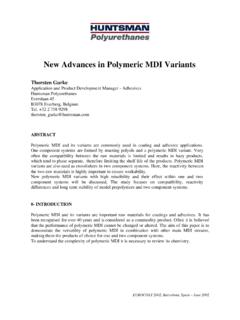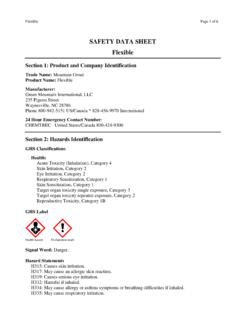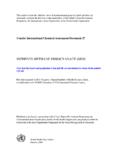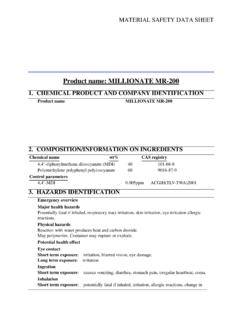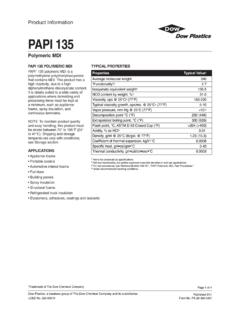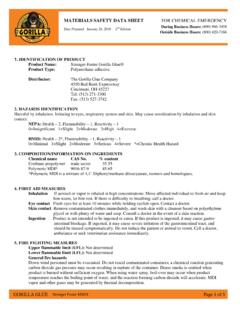Transcription of Product: FROTH-PAK(TM) Sealant 200HFC Kit Issue …
1 Product: FROTH-PAK(TM) Sealant 200 HFC KitIssue Date: 03/15/10 Isocyanate SDS pages 2-14 Effective Date: 03/15/10 Polyol SDS pages 15-29 ( )*Trademark of The Dow Chemical Company 1 of 30 NOTICE The Material Safety Data Sheet information for the two component FROTH-PAK(TM) Sealant 200 HFC Kit is contained in two separate datasheets; one for the isocyanate and one for the polyol. When printing or filing, please be sure to include both : FROTH-PAK(TM) Sealant 200 HFC Kit Issue Date: 03/15/10 Isocyanate SDS pages 2-14 Effective Date: 03/15/10 Polyol SDS pages 15-28 ( )*Trademark of The Dow Chemical Company 2 of 30 The Dow Chemical Company encourages and expects you to read and understand the entire (M)SDS, as there is important information throughout the document.
2 We expect you to follow the precautions identified in this document unless your use conditions would necessitate other appropriate methods or actions. 1. Product and Company Identification Product Name Polyurethane System Isocyanate COMPANY IDENTIFICATIONThe Dow Chemical Company 2030 Willard H. Dow Center Midland, MI 48674 USAC ustomer Information Number: 800-258-2436 EMERGENCY TELEPHONE NUMBER24-Hour Emergency Contact:989-636-4400 Local Emergency Contact:989-636-4400 2. Hazards Identification Emergency OverviewColor: BrownPhysical State: Liquid. Odor:Musty Material Safety Data SheetThe Dow Chemical CompanyProduct: FROTH-PAK(TM) Sealant 200 HFC Kit Issue Date: 03/15/10 Isocyanate SDS pages 2-14 Effective Date: 03/15/10 Polyol SDS pages 15-28 ( )*Trademark of The Dow Chemical Company 3 of 30 Hazards of Product: WARNING!
3 May cause eye irritation. May cause skin irritation. May cause allergic skin reaction. May cause allergic respiratory reaction. Vapor reduces oxygen available for breathing. May cause central nervous system effects. Keep upwind of spill. May cause anesthetic effects. May cause respiratory tract irritation. May cause lung injury. May react with water. Stay out of low areas. Material reacts slowly with water, releasing carbon dioxide which can cause pressure buildup and rupture of closed containers. Elevated temperatures accelerate this reaction. Toxic fumes may be released in fire situations. Contents under pressure. OSHA Hazard Communication StandardThis product is a "Hazardous Chemical" as defined by the OSHA Hazard Communication Standard, 29 CFR Potential Health EffectsEye Contact: May cause moderate eye irritation. May cause slight temporary corneal injury. Skin Contact: Prolonged contact may cause skin irritation with local redness.
4 May stain skin. Skin Absorption:Prolonged skin contact is unlikely to result in absorption of harmful amounts. Skin Sensitization:Skin contact may cause an allergic skin reaction. Animal studies have shown that skin contact with isocyanates may play a role in respiratory sensitization. Inhalation:In confined or poorly ventilated areas, vapor can easily accumulate and can cause unconsciousness and death due to displacement of oxygen. Excessive exposure may cause irritation to upper respiratory tract (nose and throat) and lungs. May cause pulmonary edema (fluid in the lungs.) Effects may be delayed. Decreased lung function has been associated with overexposure to isocyanates. Excessive exposure may increase sensitivity to epinephrine and increase myocardial irritability (irregular heartbeats). May cause central nervous system effects. Symptoms of excessive exposure may be anesthetic or narcotic effects; dizziness and drowsiness may be observed.
5 Respiratory Sensitization:May cause allergic respiratory response. MDI concentrations below the exposure guidelines may cause allergic respiratory reactions in individuals already sensitized. Asthma-like symptoms may include coughing, difficult breathing and a feeling of tightness in the chest. Occasionally, breathing difficulties may be life threatening. Ingestion:Low toxicity if swallowed. Small amounts swallowed incidentally as a result of normal handling operations are not likely to cause injury; however, swallowing larger amounts may cause injury. Observations in animals include: Gastrointestinal irritation. Effects of Repeated Exposure:Tissue injury in the upper respiratory tract and lungs has been observed in laboratory animals after repeated excessive exposures to MDI/polymeric MDI aerosols. Cancer Information:Lung tumors have been observed in laboratory animals exposed to respirable aerosol droplets of MDI/Polymeric MDI (6 mg/m3) for their lifetime.
6 Tumors occurred concurrently with respiratory irritation and lung injury. Current exposure guidelines are expected to protect against these effects reported for MDI. Birth Defects/Developmental Effects:In laboratory animals, MDI/polymeric MDI did not cause birth defects; other fetal effects occurred only at high doses which were toxic to the mother. Product: FROTH-PAK(TM) Sealant 200 HFC Kit Issue Date: 03/15/10 Isocyanate SDS pages 2-14 Effective Date: 03/15/10 Polyol SDS pages 15-28 ( )*Trademark of The Dow Chemical Company 4 of 30 Based on information for component(s): 1,1,1,2-Tetrafluoroethane. Has been toxic to the fetus in laboratory animals at doses toxic to the mother. ComponentCAS # Amount Diphenylmethane Diisocyanate, isomers and homologues9016-87-9>= - <= %4,4' -Methylenediphenyl diisocyanate101-68-8>= - <= %1,1,1,2-Tetrafluoroethane811-97-2>= - <= %Note: CAS 101-68-8 is an MDI isomer that is part of CAS 9016-87-9.
7 4. First-aid measures Eye Contact: Immediately flush eyes with water; remove contact lenses, if present, after the first 5 minutes, then continue flushing eyes for at least 15 minutes. Obtain medical attention without delay, preferably from an ophthalmologist. Eye wash fountain should be located in immediate work area. Skin Contact: Remove material from skin immediately by washing with soap and plenty of water. Remove contaminated clothing and shoes while washing. Seek medical attention if irritation persists. Wash clothing before reuse. An MDI skin decontamination study demonstrated that cleaning very soon after exposure is important, and that a polyglycol-based skin cleanser or corn oil may be more effective than soap and water. Discard items which cannot be decontaminated, including leather articles such as shoes, belts and watchbands. Inhalation: Move person to fresh air.
8 If not breathing, give artificial respiration; if by mouth to mouth use rescuer protection (pocket mask, etc). If breathing is difficult, oxygen should be administered by qualified personnel. Call a physician or transport to a medical : If swallowed, seek medical attention. Do not induce vomiting unless directed to do so by medical personnel. Notes to Physician: Maintain adequate ventilation and oxygenation of the patient. May cause respiratory sensitization or asthma-like symptoms. Bronchodilators, expectorants and antitussives may be of help. Treat bronchospasm with inhaled beta2 agonist and oral or parenteral corticosteroids. Respiratory symptoms, including pulmonary edema, may be delayed. Persons receiving significant exposure should be observed 24-48 hours for signs of respiratory distress. If you are sensitized to diisocyanates, consult your physician regarding working with other respiratory irritants or sensitizers.
9 Exposure may increase "myocardial irritability". Do not administer sympathomimetic drugs such as epinephrine unless absolutely necessary. Treatment of exposure should be directed at the control of symptoms and the clinical condition of the patient. Medical Conditions Aggravated by Exposure: Excessive exposure may aggravate preexisting asthma and other respiratory disorders ( emphysema, bronchitis, reactive airways dysfunction syndrome). InformationProduct: FROTH-PAK(TM) Sealant 200 HFC Kit Issue Date: 03/15/10 Isocyanate SDS pages 2-14 Effective Date: 03/15/10 Polyol SDS pages 15-28 ( )*Trademark of The Dow Chemical Company 5 of 30 Emergency Personnel Protection: First Aid responders should pay attention to self-protection and use the recommended protective clothing (chemical resistant gloves, splash protection).
10 If potential for exposure exists refer to Section 8 for specific personal protective equipment. 5. Fire Fighting Measures Extinguishing Media: Water fog or fine spray. Dry chemical fire extinguishers. Carbon dioxide fire extinguishers. Foam. Do not use direct water stream. May spread fire. Alcohol resistant foams (ATC type) are preferred. General purpose synthetic foams (including AFFF) or protein foams may function, but will be less effective. Fire Fighting Procedures: Keep people away. Isolate fire and deny unnecessary entry. Stay upwind. Keep out of low areas where gases (fumes) can accumulate. Water is not recommended, but may be applied in large quantities as a fine spray when other extinguishing agents are not available. Do not use direct water stream. May spread fire. Fight fire from protected location or safe distance. Consider the use of unmanned hose holders or monitor nozzles.
